Dive into world facts that showcase the evolution of technology. From ancient tools to cutting-edge breakthroughs, our technology facts page reveals how innovation has transformed the way we live, work, and connect across the globe.
Tech Facts – Visual Art Style
Type – A futuristic precision tech-style photorealistic digital illustration
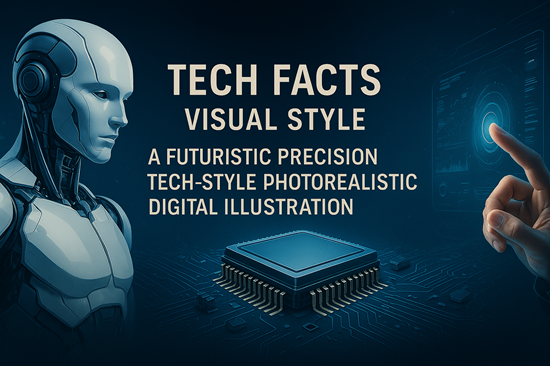
Quantum Computers
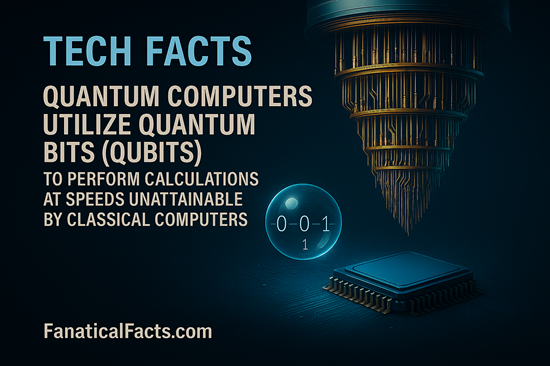
Quantum computers utilize quantum bits (qubits)
One of the most groundbreaking technology facts is that quantum computers utilize quantum bits (qubits) to perform calculations at speeds unattainable by classical computers. Unlike traditional bits, which represent either 0 or 1, qubits can exist in multiple states simultaneously, thanks to quantum superposition. This capability allows quantum computers to solve certain complex problems exponentially faster. While still in the developmental stage, quantum computing promises to revolutionize industries by enabling advancements in cryptography, drug discovery, and optimization problems. Explore more intriguing technology facts at FanaticalFacts.com and delve into the innovations shaping our future.
First Computer Bug

The term “computer bug” originated from an actual insect
One of the most intriguing technology facts is that the term “computer bug” originated from an actual insect. In 1947, engineers working on Harvard’s Mark II computer discovered a moth causing a malfunction and documented it as the “first actual case of bug being found.” This incident not only introduced the term “debugging” but also highlighted the importance of meticulous maintenance in early computing systems. Explore more fascinating technology facts at FanaticalFacts.com and delve into the quirky origins of modern tech terminology.
First Computer Mouse

The first computer mouse was crafted from wood
One of the most intriguing technology facts is that the first computer mouse was crafted from wood. Invented by Douglas Engelbart in 1964, this early prototype featured a wooden block with two metal wheels and a single button. Despite its simplicity, it revolutionized human-computer interaction, paving the way for the intuitive devices we use today. Explore more fascinating technology facts at FanaticalFacts.com and delve into the innovations that have shaped our digital world.
The First Computer Virus
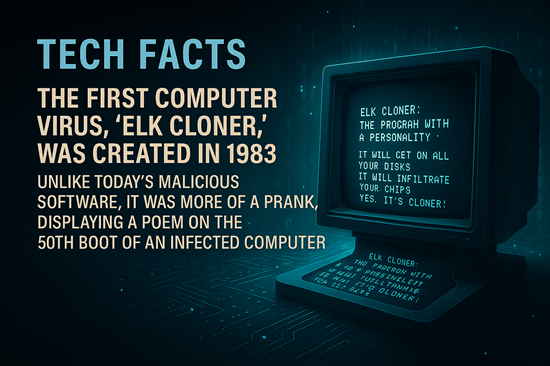
The first computer virus “Elk Cloner” was created in 1983
One of the most intriguing technology facts is that the first computer virus, “Elk Cloner,” was created in 1983. Unlike today’s malicious software, it was more of a prank, displaying a poem on the 50th boot of an infected computer. This early virus spread via floppy disks, highlighting how even simple programs can have widespread effects. It marked the beginning of the digital age’s cybersecurity challenges. Explore more fascinating technology facts at FanaticalFacts.com and learn about the innovations that have shaped our digital world.
Google BackRub

Google’s journey began with a search engine named “BackRub
One of the most intriguing technology facts is that Google’s journey began with a search engine named “BackRub.” Developed in 1996 by Stanford PhD students Larry Page and Sergey Brin. BackRub utilized backlinks to assess the significance of web pages. This innovative approach led to the creation of PageRank, Google’s foundational algorithm that revolutionized search engine technology. Explore more fascinating technology facts at FanaticalFacts.com and discover the innovations that have shaped our digital world.
The Apollo 11 Guidance Computer
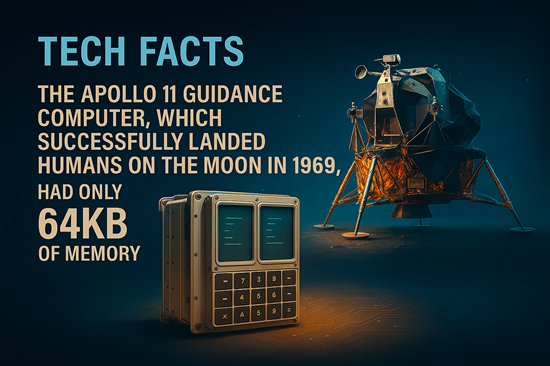
Apollo 11 Guidance Computer
One of the most remarkable technology facts is that the Apollo 11 Guidance Computer, which successfully landed humans on the Moon in 1969, operated at a mere 0.043 MHz and had only 64KB of memory. In comparison, today’s smartphones feature processors running at speeds over 2.5 GHz and offer storage capacities up to 512GB. This exponential increase in computing power underscores the rapid advancements in technology over the past five decades. Explore more fascinating technology facts at FanaticalFacts.com and delve into the innovations that have shaped our digital world.
New EV batteries
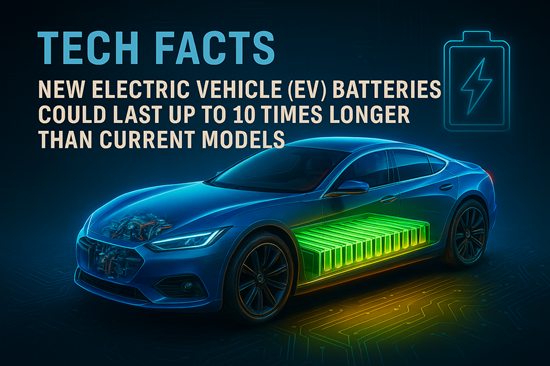
(EV) batteries could last up to 10 times longer
One of the most groundbreaking technology facts is that new electric vehicle (EV) batteries could last up to 10 times longer than current models. Researchers at Dalhousie University have developed a single-crystal electrode battery that has undergone over 20,000 charge cycles without significant degradation. This advancement translates to approximately 8 million kilometers of driving, far exceeding the typical lifespan of conventional EV batteries. Such innovations promise to revolutionize the EV industry by enhancing vehicle longevity and reducing the frequency of battery replacements. Explore more fascinating technology facts at FanaticalFacts.com and stay informed about the latest advancements shaping our digital world.
Supersonic Transport
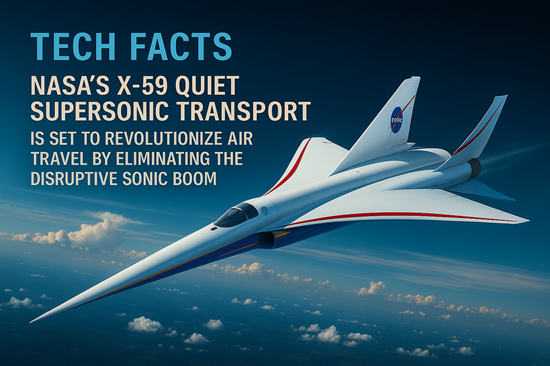
NASA’s X-59 Quiet Supersonic Transport
One of the most groundbreaking technology facts is that NASA’s X-59 Quiet Supersonic Transport is set to revolutionize air travel by eliminating the disruptive sonic boom. In collaboration with Lockheed Martin, NASA has developed the X-59 to produce a soft “thump” instead of the traditional sonic boom, enabling supersonic flights over land. This innovation could dramatically reduce flight times, such as cutting the journey from New York to London to approximately 3.5 hours. Scheduled for flight testing in 2025, the X-59 marks a significant advancement in aviation technology. Explore more fascinating technology facts at FanaticalFacts.com and stay informed about the innovations shaping our digital world.
PC Memory
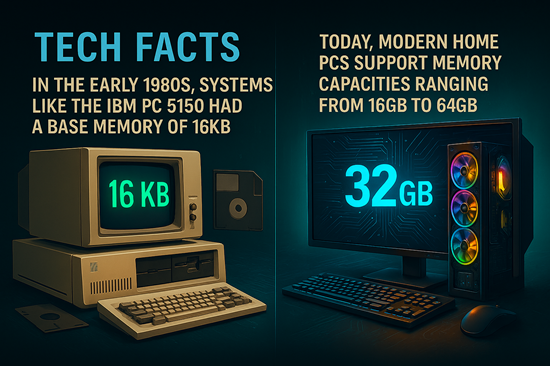
Personal Computers
One of the most remarkable technology facts is the significant evolution of memory expansion in home PCs. In the early 1980s, systems like the IBM PC 5150 had a base memory of 16KB, expandable up to 256KB. By the late 1980s, models such as the IBM Personal Computer XT featured 128KB of base memory, expandable to 640KB. Advancements continued into the 1990s with the introduction of the Compaq Deskpro 386, which supported up to 16MB of RAM. Today, modern home PCs support memory capacities ranging from 16GB to 64GB and beyond, showcasing the remarkable progress in memory expansion technology. Explore more fascinating technology facts at FanaticalFacts.com and stay informed about the innovations shaping our digital world.
The Concorde
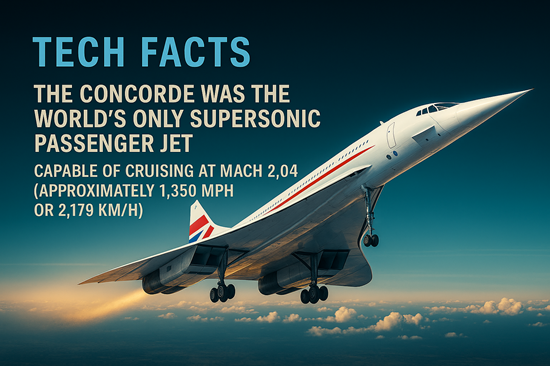
The Concorde
One of the most fascinating technology facts is that the Concorde was the world’s only supersonic passenger jet, capable of cruising at Mach 2.04 (approximately 1,350 mph or 2,179 km/h). This remarkable speed allowed it to reduce transatlantic flight times to under 3.5 hours. Equipped with a sleek delta-wing design and powerful Rolls-Royce/SNECMA Olympus 593 engines, the Concorde flew at altitudes up to 60,000 feet, well above most commercial air traffic. Despite its technological advancements, the Concorde was retired in 2003 due to high operational costs and changing market demands. Explore more fascinating technology facts at FanaticalFacts.com and stay informed about the innovations shaping our digital world.
More to Explore


Explore the fascinating world of facts through our featured categories below. Each image link takes you directly to a curated section of FanaticalFacts.com. Designed with both visual engagement and intuitive navigation in mind.





